Spatial-Temporal Evolution and Its Influencing Factors on Urban Land Use Efficiency in China’s Yangtze River Economic Belt
Abstract
:1. Introduction
2. Materials and Methods
2.1. Research Area
2.2. Research Methods
2.2.1. Un_Super_SBM Model
2.2.2. Kernel Density Estimation
2.2.3. Spatial Correlation Analysis Model
2.2.4. Econometric Model Construction
2.3. Research Variable and Data Source
3. Results
3.1. Time Series Characteristics and Spatial-Temporal Evolution Analysis of ULUE
3.1.1. Time Series Characteristics
3.1.2. Spatial-Temporal Evolution Analysis
3.2. Spatial Correlation Analysis
3.2.1. Global Spatial Autocorrelation Analysis
3.2.2. Local Spatial Autocorrelation Analysis
3.3. Influencing Factors of Effects of ULUE
3.3.1. Spatial Econometric Model Test
3.3.2. SDM Results Analysis
4. Discussion and Conclusions
4.1. Discussion
4.2. Conclusions
- (1)
- The time series characteristics show that the overall ULUE of the YREB is continuously improving. The ULUE of cities finally showed the characteristics of “lower in the west but higher in the east.” The number of high ULUE cities in the YREB generally increase, but concentrate in the eastern region. The medium efficiency value cities concentrate in cities in the central region while most cities in the western region are still in low efficiency. The peaks of the KDE result in the whole region and sub-regions presented a “steep at first and then gentle” trend. The improvement in ULUE and regional synergy in these cities of the eastern and central regions is faster than cities in the western region.
- (2)
- The spatial correlation of ULUE in the YREB has been increasing year after year, and the overall correlation is positive. The local spatial autocorrelation results show a spatial shift in ULUE. Specifically, the H-H agglomeration shifted to cities in the eastern region, the L-L agglomeration shifted to cities in the western region, and the L-H agglomeration and H-L agglomeration showed a scattered distribution. The Gi* index distribution results are consistent with the Lisa index results, and the hot spots and cold spots of ULUE are distributed regionally. Overall, the hot spots migrated to the east, and the cold spots migrated to the west, with a spreading trend.
- (3)
- The results of the spatial Dobbin model show that Urban, Gov and IST can promote the improvement of ULUE, and PD and LUS can inhibit the improvement of ULUE. The decomposition effect shows that the direct effect of Urban is negative but the indirect is positive; the direct of PD is positive but the indirect effect is negative; both the direct and indirect effects of Gov and IST are positive; both the direct and indirect effects of LUS are negative. The results of heterogeneity show that: economic activities in resource-based cities have a negative impact on ULUE, but industrial transformation will promote it. The economic activities of non-resource-based cities can promote ULUE, but the promotion effect of industrial transformation is not obvious.
Author Contributions
Funding
Data Availability Statement
Acknowledgments
Conflicts of Interest
References
- Huang, L.J.; Yang, P.; Zhang, B.Q.; Hu, W.Y. Spatio-temporal coupling characteristics and the driving mechanism of population-land-industry urbanization in the yangtze river economic belt. Land 2021, 10, 400. [Google Scholar] [CrossRef]
- Jing, S.Q.; Yan, Y.G.; Niu, F.Q.; Song, W.H. Urban expansion in china: Spatiotemporal dynamics and determinants. Land 2022, 11, 356. [Google Scholar] [CrossRef]
- Wu, C.Y.; Wei, Y.H.D.; Huang, X.J.; Chen, B.W. Economic transition, spatial development and urban land use efficiency in the Yangtze River Delta, China. Habitat Int. 2017, 63, 67–78. [Google Scholar] [CrossRef]
- Qu, L.L.; Liu, Y.S.; Chen, Z.F. Spatio-temporal evolution of ecologically-sustainable land use in China’s loess plateau and detection of its influencing factors. J. Mt. Sci. 2019, 16, 1065–1074. [Google Scholar] [CrossRef]
- Zhang, X.P.; Lu, X.H.; Chen, D.L.; Zhang, C.Z.; Ge, K.; Kuang, B.; Liu, S. Is environmental regulation a blessing or a curse for China’s urban land use efficiency? Evidence from a threshold effect model. Growth Chang. 2021, 52, 12465. [Google Scholar] [CrossRef]
- Koroso, N.H.; Zevenbergen, J.A.; Lengoiboni, M. Urban land use efficiency in ethiopia: An assessment of urban land use sustainability in addis ababa. Land Use Policy 2020, 99, 102437. [Google Scholar] [CrossRef]
- Alejandro, C.; Roberto, P.L.; Diego Fabián, L.G. Urban form, land use, and cover change and their impact on carbon emissions in the Monterrey Metropolitan Area, Mexico. Urban Clim. 2021, 39, 100947. [Google Scholar] [CrossRef]
- Song, Y.; Yeung, G.; Zhu, D.L.; Xu, Y.; Zhang, L.X. Efficiency of urban land use in China’s resource-based cities, 2000–2018. Land Use Policy 2022, 115, 106009. [Google Scholar] [CrossRef]
- Li, Y.L.; Shu, B.R.; Wu, Q. Urban Land Use Efficiency in China: Spatial and Temporal Characteristics, Regional Difference and Influence Factors. Econ. Geogr. 2014, 34, 133–139. [Google Scholar] [CrossRef]
- Liang, L.T.; Zhao, Q.L.; Chen, C. Analysis on the characters of spatial disparity of urban land use efficiency and its optimization in China. China Land Sci. 2013, 27, 48–54. [Google Scholar] [CrossRef]
- Ye, C.; Zhu, J.J.; Li, S.M.; Yang, S.; Chen, M.X. Assessment and analysis of regional economic collaborative development within an urban agglomeration: Yangtze River Delta as a case study. Habitat Int. 2019, 83, 20–29. [Google Scholar] [CrossRef]
- Liu, Y.P. Land Scale Management and agricultural environmental efficiency: An empirical analysis based on SBM tobit model. Jiangsu Agric. Sci. 2019, 47, 306–310. [Google Scholar] [CrossRef]
- Bao, X.Z.; Liu, C.; Zhang, J.B. Comprehensive evaluation of urban land use efficiency. Urban Issues 2009, 4, 46–50. [Google Scholar]
- Liu, S.C.; Ye, Y.M.; Xiao, W. Temporal and spatial differences and driving factors of land use efficiency in four urban agglomerations in Eastern China. Urban Issues 2020, 88, 14–20. [Google Scholar] [CrossRef]
- Liu, S.C.; Lin, Y.B.; Ye, Y.M.; Xiao, W. Spatial-temporal characteristics of industrial land use efficiency in provincial China based on a stochastic frontier production function approach. J. Clean. Prod. 2021, 295, 126432. [Google Scholar] [CrossRef]
- Song, J.F.; Chen, X.N. Eco-efficiency of grain production in China based on water footprints: A stochastic frontier approach. J. Clean. Prod. 2019, 236, 117685. [Google Scholar] [CrossRef]
- Färe, R.; Grosskopf, S. Directional distance functions and slacks-based measures of efficiency. Eur. J. Oper. Res. 2010, 200, 320–322. [Google Scholar] [CrossRef]
- Tone, K. A slacks-based measure of efficiency in data envelopment analysis. Eur. J. Oper. Res. 2001, 130, 498–509. [Google Scholar] [CrossRef] [Green Version]
- Yang, Q.K.; Duan, X.J.; Ye, L.; Zhan, W. Efficiency evaluation of city land utilization in the Yangtze River Delta using a SBM-undesirable model. Resour. Sci. 2014, 36, 712–721. [Google Scholar]
- Chen, B.P.; Liu, Y.; He, L.L. Study on agricultural land use efficiency based on DEA and malmquist index–taking Gansu province as an example. Technol. Econ. 2021, 34, 51–55. [Google Scholar] [CrossRef]
- Wang, Y.Y.; Liu, Y.J.; Zhou, G.L.; Ma, Z.P.; Sun, H.R.; Fu, H. Coordinated relationship between compactness and land-use efficiency in shrinking cities: A case study of Northeast China. Land 2022, 11, 366. [Google Scholar] [CrossRef]
- Li, J.; Hu, B.X.; Kuang, B.; Chen, D.L. Measuring of urban land use efficiency and its dynamic development in China. Econ. Geogr. 2017, 37, 162–167. [Google Scholar] [CrossRef]
- Yan, S.Q.; Peng, J.C.; Wu, Q. Exploring the non-linear effects of city size on urban industrial land use efficiency: A spatial econometric analysis of cities in Eastern China. Land Use Policy 2020, 99, 104944. [Google Scholar] [CrossRef]
- Zhao, S.D.; Zhao, K.X.; Yan, Y.R.; Zhu, K.; Guan, C.M. Spatio-temporal evolution characteristics and influencing factors of urban service-industry land in China. Land 2021, 11, 13. [Google Scholar] [CrossRef]
- Xue, D.; Yue, L.; Ahmad, F.; Draz, M.U.; Chandio, A.A.; Ahmad, M.; Amin, W. Empirical investigation of urban land use efficiency and influencing factors of the Yellow River Basin Chinese Cities. Land Use Policy 2022, 117, 106117. [Google Scholar] [CrossRef]
- Jiang, H.L. Spatial–temporal differences of industrial land use efficiency and its influencing factors for China’s Central Region: Analyzed by SBM model. Environ. Technol. Innov. 2021, 22, 101489. [Google Scholar] [CrossRef]
- Xie, H.L.; Chen, Q.R.; Lu, F.C.; Wang, W.; Yao, G.R.; Yu, J.L. Spatial-temporal disparities and influencing factors of total-factor green use efficiency of industrial land in China. J. Clean. Prod. 2019, 207, 1047–1058. [Google Scholar] [CrossRef]
- Yin, Y.Q.; Hou, X.H.; Liu, J.M.; Zhou, X.; Zhang, D.J. Detection and attribution of changes in cultivated land use ecological efficiency: A case study on Yangtze River Economic Belt, China. Ecol. Indic. 2022, 137, 108753. [Google Scholar] [CrossRef]
- Cui, X.L.; Shen, Z.; Li, Z.H.; Wu, J. Spatiotemporal evolutions and driving factors of green development performance of cities in the Yangtze River Economic Belt. Ecol. Inform. 2021, 66, 101476. [Google Scholar] [CrossRef]
- Liu, Y.L.; Zhang, X.H.; Kong, X.S.; Wang, R.; Chen, L. Identifying the relationship between urban land expansion and human activities in the Yangtze River Economic Belt, China. Appl. Geogr. 2018, 94, 163–177. [Google Scholar] [CrossRef]
- Chen, Y.S.; Zhang, S.H.; Huang, D.S.; Li, B.L.; Liu, J.G.; Liu, W.J.; Ma, J.; Wang, F.; Wang, Y.; Wu, S.J.; et al. The development of China’s Yangtze River economic belt: How to make it in a green way? Sci. Bull. 2017, 62, 648–651. [Google Scholar] [CrossRef] [Green Version]
- Hou, X.H.; Liu, J.M.; Zhang, D.J.; Zhao, M.J.; Xia, C.Y. Impact of urbanization on the eco-efficiency of cultivated land utilization: A case study on the Yangtze River Economic Belt, China. J. Clean. Prod. 2019, 238, 117916. [Google Scholar] [CrossRef]
- Tone, K. A Slacks-based measure of super-efficiency in data envelopment analysis. Eur. J. Oper. Res. 2002, 143, 32–41. [Google Scholar] [CrossRef] [Green Version]
- Du, J.; Liang, L.; Zhu, J. A slacks-based measure of super-efficiency in data envelopment analysis: A comment. Eur. J. Oper. Res. 2010, 204, 694–697. [Google Scholar] [CrossRef]
- Chen, G. Data Envelopment Analysis Method and Maxdea Software; Publishing House Co. Ltd.: Beijing, China, 2014. [Google Scholar]
- Ji, Y.D.; Li, Y.; Yao, N.; Biswas, A.; Chen, X.G.; Li, L.C.; Pulatov, A.; Liu, F.G. Multivariate global agricultural drought frequency analysis using kernel density estimation. Ecol. Eng. 2022, 177, 106550. [Google Scholar] [CrossRef]
- Burkhauser, R.V.; Rovba, L. Income inequality in the 1990s: Comparing the United States, Great Britain and Germany. Discuss. Pap. DIW Berl. 2006, 2006, 576. [Google Scholar]
- Zhang, L.G.; Leng, L.P.; Zeng, Y.M. An analysis of the spatial-temporal evolution and driving factors of urban innovation capability along the Yangtze River Economic Belt: From the perspective of flowing human capital. Contemp. Financ. Econ. 2020, 14–26. [Google Scholar] [CrossRef]
- Han, L.; He, T.T.; Yang, Y. Coupling coordination evaluation of high-quality development and land use efficiency of urban agglomeration–empirical analysis of seven urban agglomerations in the Yellow River Basin. J. Henan Norm. Univ. (Philos. Soc. Sci.) 2021, 48, 95–101. [Google Scholar] [CrossRef]
- Jin, G.; Wu, F.; Li, Z.H.; Guo, B.S.; Zhao, X.D. Estimation and analysis of land use and ecological efficiency in rapid urbanization area. Acta Ecol. Sin. 2017, 37, 8048–8057. [Google Scholar]
- Zheng, Q.M.; Weng, Q.H.; Wang, K. Developing a new cross-sensor calibration model for DMSP-OLS and Suomi-NPP VIIRS night-light imageries. ISPRS J. Photogramm. Remote Sens. 2019, 153, 36–47. [Google Scholar] [CrossRef]
- Elvidge, C.; Zhizhin, M.; Tilottama, G.; Hsu, F.C.; Taneja, J. Annual time series of global VIIRS nighttime lights derived from monthly averages: 2012 to 2019. Remote Sens. 2021, 13, 922. [Google Scholar] [CrossRef]
- Fu, Y.H.; Zhou, T.T.; Yao, Y.Y.; Qiu, A.; Wei, F.Q.; Liu, J.Q.; Liu, T. Evaluating efficiency and order of urban land use structure: An empirical study of cities in Jiangsu, China. J. Clean. Prod. 2021, 283, 124638. [Google Scholar] [CrossRef]
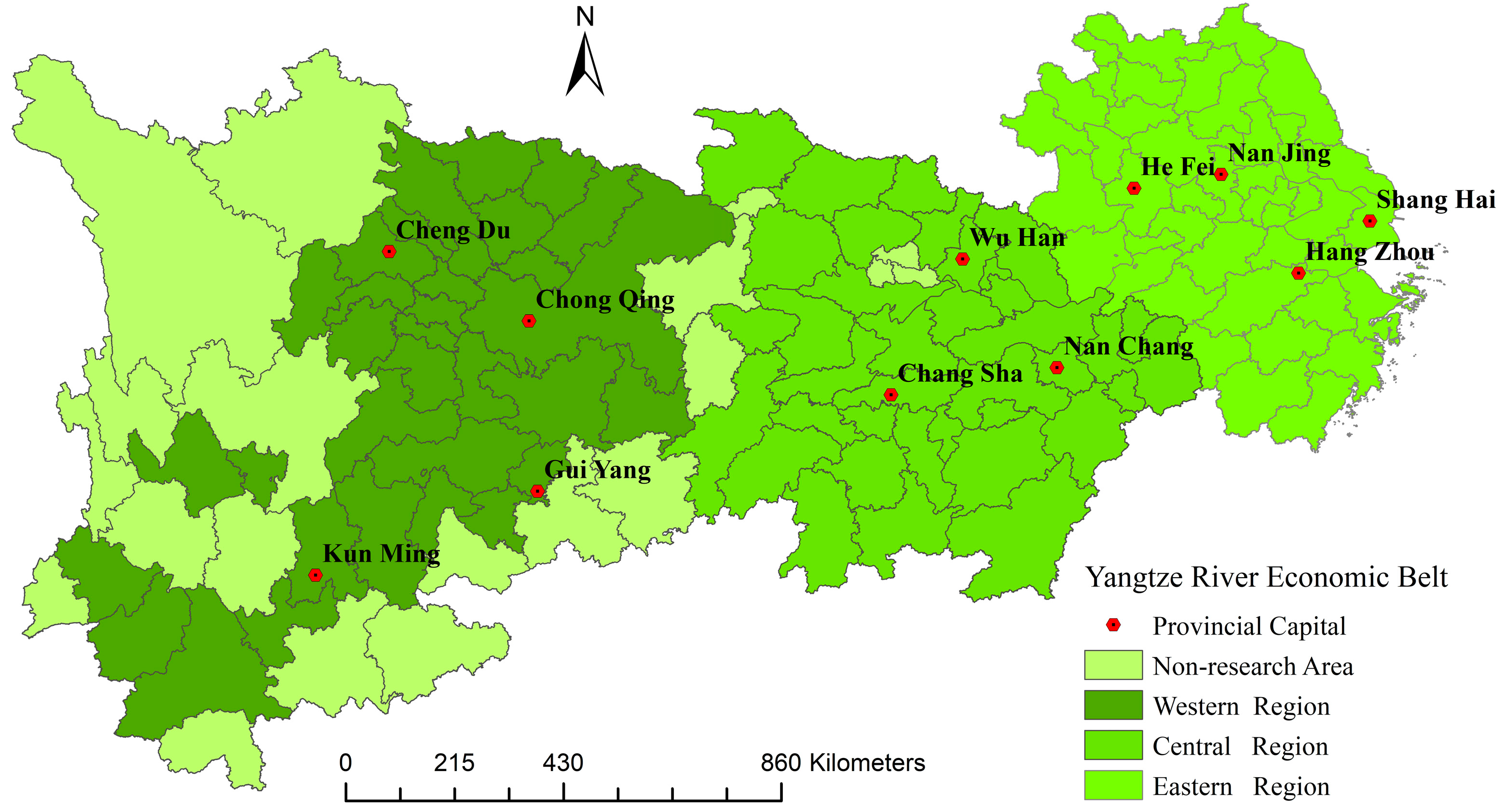
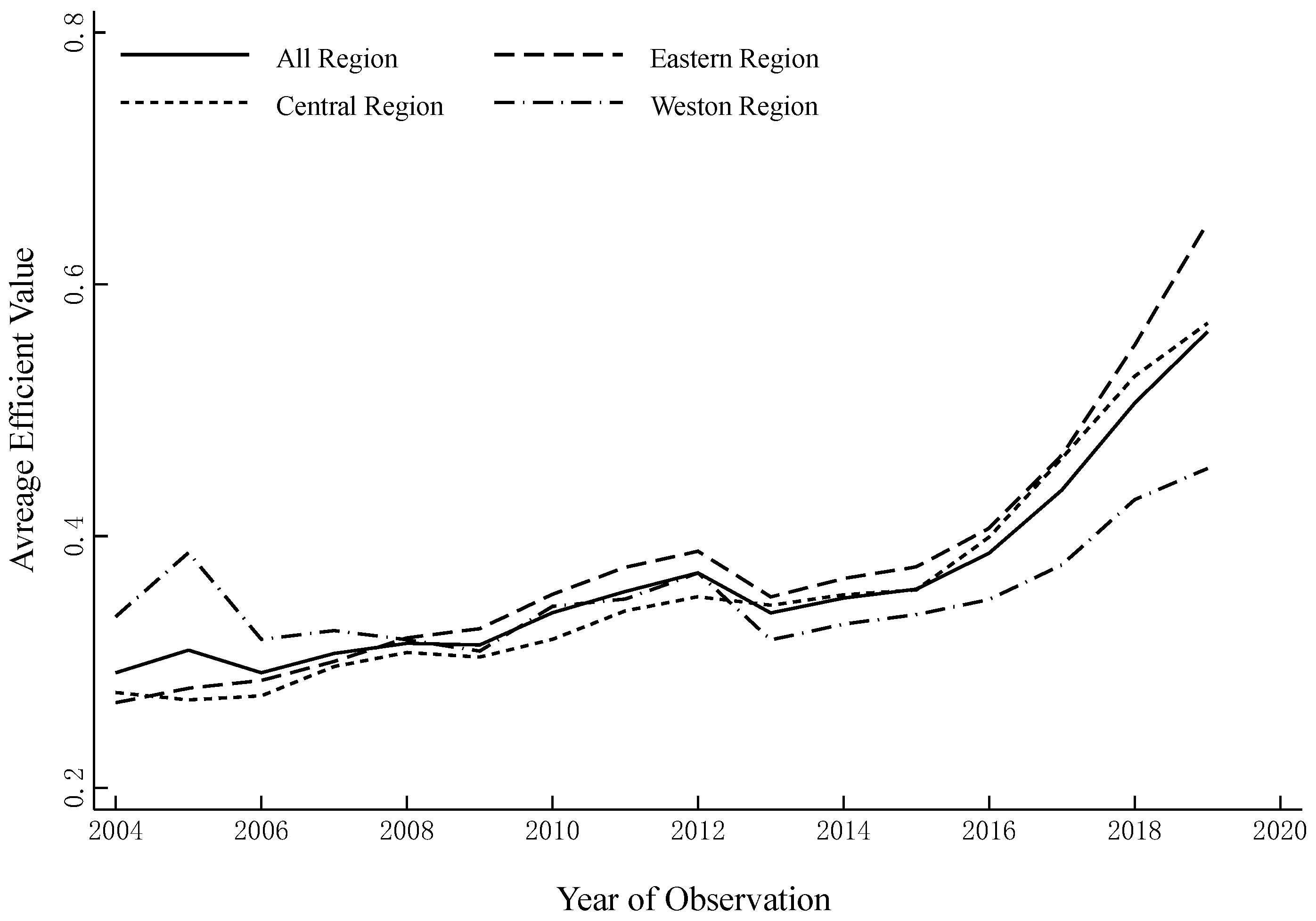
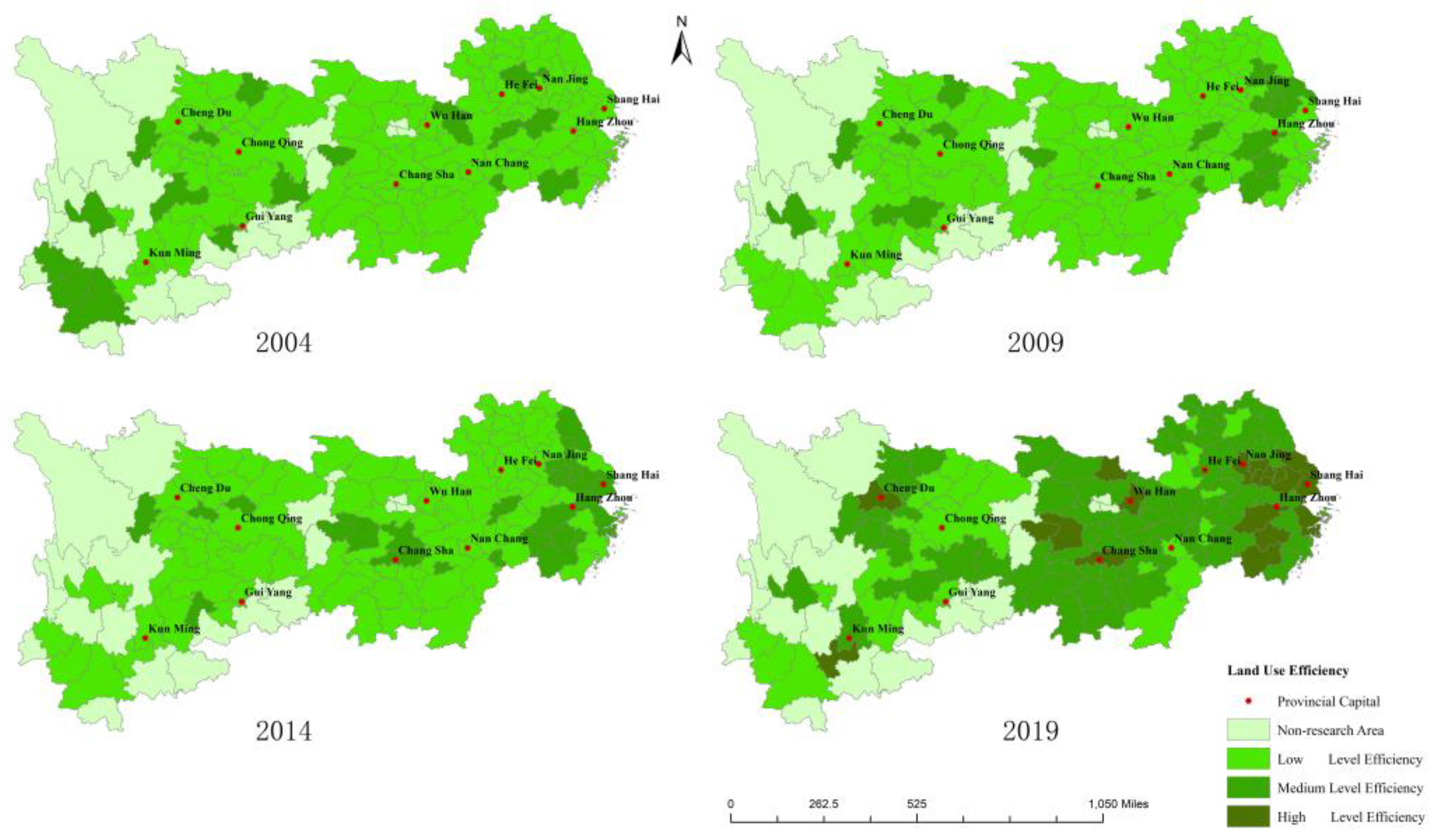

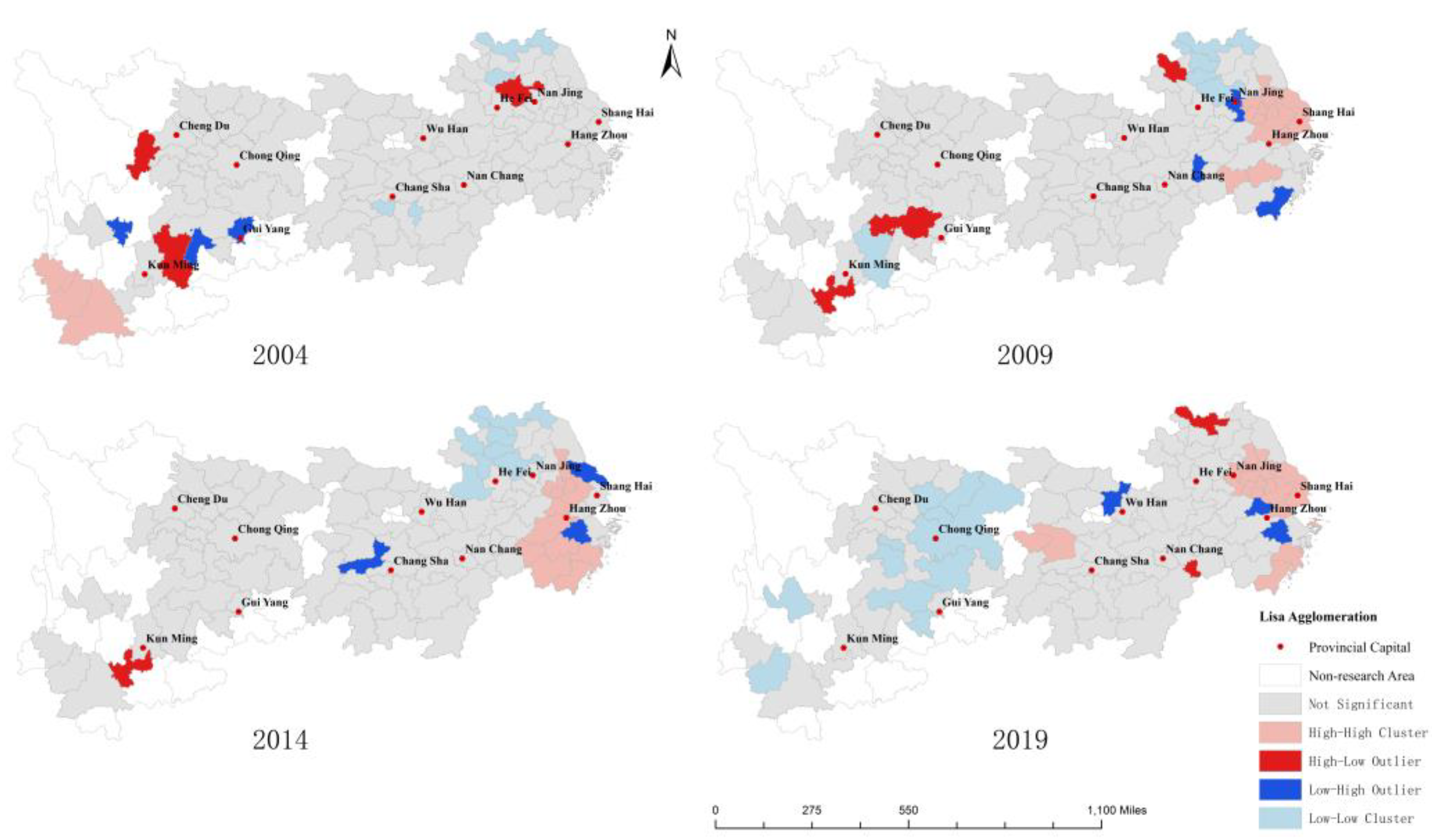
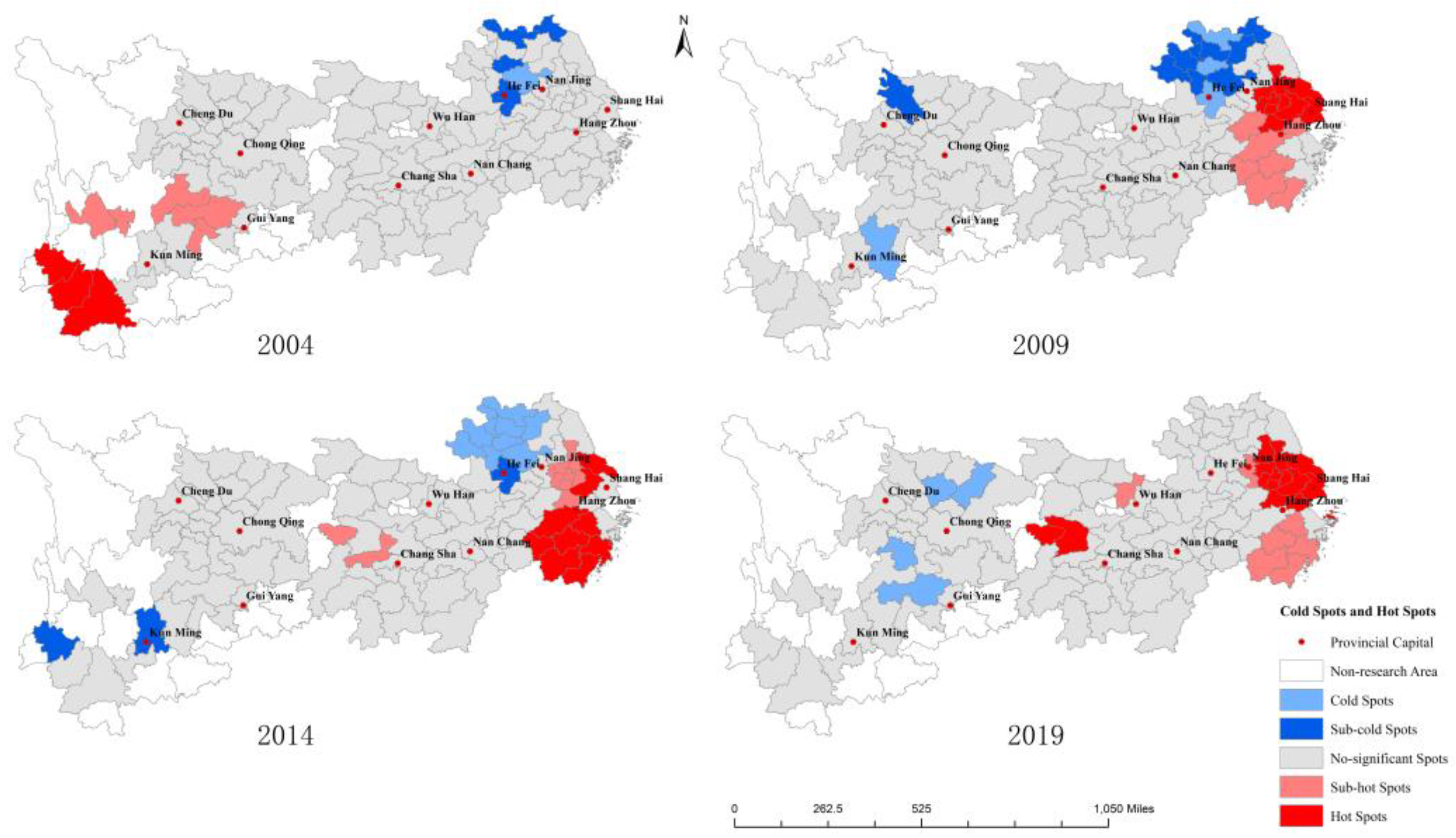
| Index | Variable | Unit | |
|---|---|---|---|
| Input | Land | Built-up area | Km2 |
| Capital | Total fixed-asset investment | million | |
| Labor | The number of employments in the secondary and tertiary industries | 10,000 people | |
| Expected output | Economic Effect | The added value of the secondary and tertiary industries | million |
| Undesired output | Industrial “Three Wastes” | Industrial wastewater discharge | 10,000 t |
| Sulfur dioxide emissions | t | ||
| Industrial soot emissions | t |
| Influence Factors | Variable | Measure |
|---|---|---|
| Dependent Variable | ULUE | Results of Un_Super_SBM |
| Independent Variable | Urban | Night-light data by fitting the corrected data of DMSP_OLS and VIIRS_VNL |
| PD | Total population/Administrative area | |
| Gov | Fiscal Budget Expenditure/GDP | |
| IST | Added value of tertiary industry / Added value of secondary industry | |
| LUS | Construction land area / Administrative area |
| Year | Moran’s I | Z-Value | p-Value |
|---|---|---|---|
| 2004 | 0.076 *** | 5.787 | 0.000 |
| 2005 | 0.055 *** | 4.466 | 0.000 |
| 2006 | 0.006 | 1.046 | 0.148 |
| 2007 | −0.008 | 0.092 | 0.463 |
| 2008 | 0.011 * | 1.439 | 0.075 |
| 2009 | 0.039 ** | 3.257 | 0.001 |
| 2010 | 0.011 * | 1.470 | 0.071 |
| 2011 | 0.031 * | 2.812 | 0.002 |
| 2012 | 0.012 * | 1.457 | 0.073 |
| 2013 | 0.062 *** | 4.835 | 0.000 |
| 2014 | 0.062 *** | 4.899 | 0.000 |
| 2015 | 0.058 *** | 4.759 | 0.000 |
| 2016 | 0.094 *** | 6.970 | 0.000 |
| 2017 | 0.086 *** | 6.556 | 0.000 |
| 2018 | 0.078 *** | 5.995 | 0.000 |
| 2019 | 0.126 *** | 9.171 | 0.000 |
| Indicator | Result |
|---|---|
| Moran’s I | 12.010 *** |
| LMerror | 123.707 *** |
| R-LMerror | 6.066 ** |
| LMlag | 168.868 *** |
| R-LMlag | 51.227 *** |
| Hausman Test | 24.13 *** |
| LR_test (SAR) | 19.25 *** |
| LR_test (SEM) | 20.46 *** |
| Indicator | OLS | Adjacency Matrix | Distance Attenuation Matrix | Economic Distance Matrix |
|---|---|---|---|---|
| Urban | −0.263 ** | −0.233 *** | −0.285 *** | −0.342 *** |
| (−2.222) | (−4.680) | (−5.287) | (−5.825) | |
| PD | 0.020 | 0.054 | 0.190 | 0.131 |
| (0.114) | (0.280) | (0.950) | (0.639) | |
| Gov | 0.060 | 0.020 | −0.004 | −0.036 |
| (0.770) | (0.430) | (−0.089) | (−0.711) | |
| IST | 0.057 | 0.016 | 0.028 | 0.035 |
| (1.427) | (0.377) | (0.591) | (0.665) | |
| LUS | −0.072 *** | −0.066 ** | −0.066 ** | −0.060 * |
| (−2.930) | (−2.109) | (−2.053) | (−1.866) | |
| Constant | 3.009 ** | |||
| (2.492) | ||||
| W* Urban | 0.287 ** | 0.474 *** | 0.486 *** | |
| (2.253) | (4.093) | (5.421) | ||
| W* PD | −4.161 ** | −3.301 *** | −1.252 ** | |
| (−2.027) | (−2.788) | (−2.235) | ||
| W* Gov | 0.480 *** | 0.414 *** | 0.306 *** | |
| (2.924) | (3.460) | (3.575) | ||
| W* IA | 0.188 ** | 0.109 | 0.145 ** | |
| (1.962) | (1.214) | (1.976) | ||
| W* IST | −0.104 | −0.241 | −0.165 ** | |
| (−0.452) | (−1.483) | (−1.979) | ||
| W* LUS | 0.287 ** | 0.474 *** | 0.486 *** | |
| (2.253) | (4.093) | (5.421) | ||
| ρ | 0.545 *** | 0.494 *** | 0.268 *** | |
| (6.200) | (6.596) | (5.606) | ||
| sigma2 | 0.081 *** | 0.081 *** | 0.081 *** | |
| (29.598) | (29.585) | (29.607) | ||
| LL | −260.715 | −295.666 | −286.729 | −289.926 |
| AIC | 563.431 | 615.332 | 597.457 | 603.852 |
| BIC | 679.638 | 681.009 | 663.134 | 669.528 |
| R2 | 0.085 | 0.076 | 0.080 | 0.064 |
| Observations | 1870 | 1760 | 1760 | 1760 |
| Indicator | Total Effect | Direct Effect | Indirect Effect |
|---|---|---|---|
| Urban | 0.382 ** | −0.277 *** | 0.659 *** |
| (2.010) | (−5.053) | (3.336) | |
| PD | −6.194 ** | 0.128 | −6.322 ** |
| (−2.457) | (0.668) | (−2.516) | |
| Gov | 0.805 *** | 0.007 | 0.798 *** |
| (3.801) | (0.155) | (3.694) | |
| IST | 0.273 ** | 0.031 | 0.242 |
| (1.980) | (0.669) | (1.605) | |
| LUS | −0.608 * | −0.070 ** | −0.539 * |
| (−1.884) | (−2.279) | (−1.680) |
| Variable | Effect | Group: Resource-Based City | Group: Position | |||
|---|---|---|---|---|---|---|
| YES | No | East | Central | West | ||
| Urban | Direct | −0.207 | 0.297 *** | 0.460 *** | −0.257 * | −0.838 |
| (−0.494) | (2.772) | (5.288) | (−1.750) | (−0.974) | ||
| Indirect | −11.074 *** | 6.150 * | 2.632 | 5.042 *** | −13.258 | |
| (−2.849) | (1.700) | (1.206) | (3.303) | (−1.049) | ||
| Total | −11.281 *** | 6.447 * | 3.092 | 4.785 *** | −14.095 | |
| (−2.838) | (1.752) | (1.382) | (3.059) | (−1.083) | ||
| PD | Direct | 0.085 | −0.069 *** | −0.025 | −0.192 *** | 0.150 |
| (0.791) | (−3.368) | (−1.140) | (−5.334) | (1.179) | ||
| Indirect | 0.458 | −0.199 | −0.269 | −0.248 ** | 0.636 | |
| (1.506) | (−0.667) | (−0.902) | (−2.123) | (0.599) | ||
| Total | 0.543 * | −0.268 | −0.293 | −0.440 *** | 0.787 | |
| (1.913) | (−0.888) | (−0.963) | (−3.893) | (0.723) | ||
| Gov | Direct | −0.045 | 0.054 *** | 0.078 *** | 0.012 | 0.024 |
| (−0.433) | (2.992) | (3.556) | (0.419) | (0.200) | ||
| Indirect | 0.392 * | 0.489 *** | 0.154 | 0.190 *** | 0.028 | |
| (1.735) | (3.696) | (0.951) | (3.325) | (0.104) | ||
| Total | 0.347 * | 0.544 *** | 0.233 | 0.201 *** | 0.052 | |
| (1.768) | (4.109) | (1.417) | (4.023) | (0.218) | ||
| IST | Direct | −0.070 | −0.056 *** | −0.067 *** | −0.035 ** | −0.118 |
| (−0.982) | (−3.709) | (−3.794) | (−1.985) | (−1.289) | ||
| Indirect | 1.354 ** | 0.250 | 0.083 | 0.294 | 0.467 | |
| (2.240) | (0.791) | (0.217) | (1.596) | (0.768) | ||
| Total | 1.285 ** | 0.193 | 0.017 | 0.259 | 0.349 | |
| (2.066) | (0.601) | (0.042) | (1.370) | (0.561) | ||
| LUS | Direct | −0.207 | 0.297 *** | 0.460 *** | −0.257 * | −0.838 |
| (−0.494) | (2.772) | (5.288) | (−1.750) | (−0.974) | ||
| Indirect | −11.074 *** | 6.150 * | 2.632 | 5.042 *** | −13.258 | |
| (−2.849) | (1.700) | (1.206) | (3.303) | (−1.049) | ||
| Total | −11.281 *** | 6.447 * | 3.092 | 4.785 *** | −14.095 | |
| (−2.838) | (1.752) | (1.382) | (3.059) | (−1.083) | ||
| Other | R2 | 0.013 | 0.098 | 0.018 | 0.107 | 0.043 |
| N | 688 | 1072 | 656 | 576 | 528 | |
| LL | −401.182 | 958.625 | 724.571 | 583.980 | −385.061 | |
| AIC | 826.364 | −1893.250 | −1425.142 | −1143.960 | 794.123 | |
| BIC | 880.770 | −1833.523 | −1371.308 | −1091.686 | 845.352 | |
Disclaimer/Publisher’s Note: The statements, opinions and data contained in all publications are solely those of the individual author(s) and contributor(s) and not of MDPI and/or the editor(s). MDPI and/or the editor(s) disclaim responsibility for any injury to people or property resulting from any ideas, methods, instructions or products referred to in the content. |
© 2022 by the authors. Licensee MDPI, Basel, Switzerland. This article is an open access article distributed under the terms and conditions of the Creative Commons Attribution (CC BY) license (https://creativecommons.org/licenses/by/4.0/).
Share and Cite
Zhang, L.; Huang, L.; Xia, J.; Duan, K. Spatial-Temporal Evolution and Its Influencing Factors on Urban Land Use Efficiency in China’s Yangtze River Economic Belt. Land 2023, 12, 76. https://doi.org/10.3390/land12010076
Zhang L, Huang L, Xia J, Duan K. Spatial-Temporal Evolution and Its Influencing Factors on Urban Land Use Efficiency in China’s Yangtze River Economic Belt. Land. 2023; 12(1):76. https://doi.org/10.3390/land12010076
Chicago/Turabian StyleZhang, Liguo, Luchen Huang, Jinglin Xia, and Kaifeng Duan. 2023. "Spatial-Temporal Evolution and Its Influencing Factors on Urban Land Use Efficiency in China’s Yangtze River Economic Belt" Land 12, no. 1: 76. https://doi.org/10.3390/land12010076






